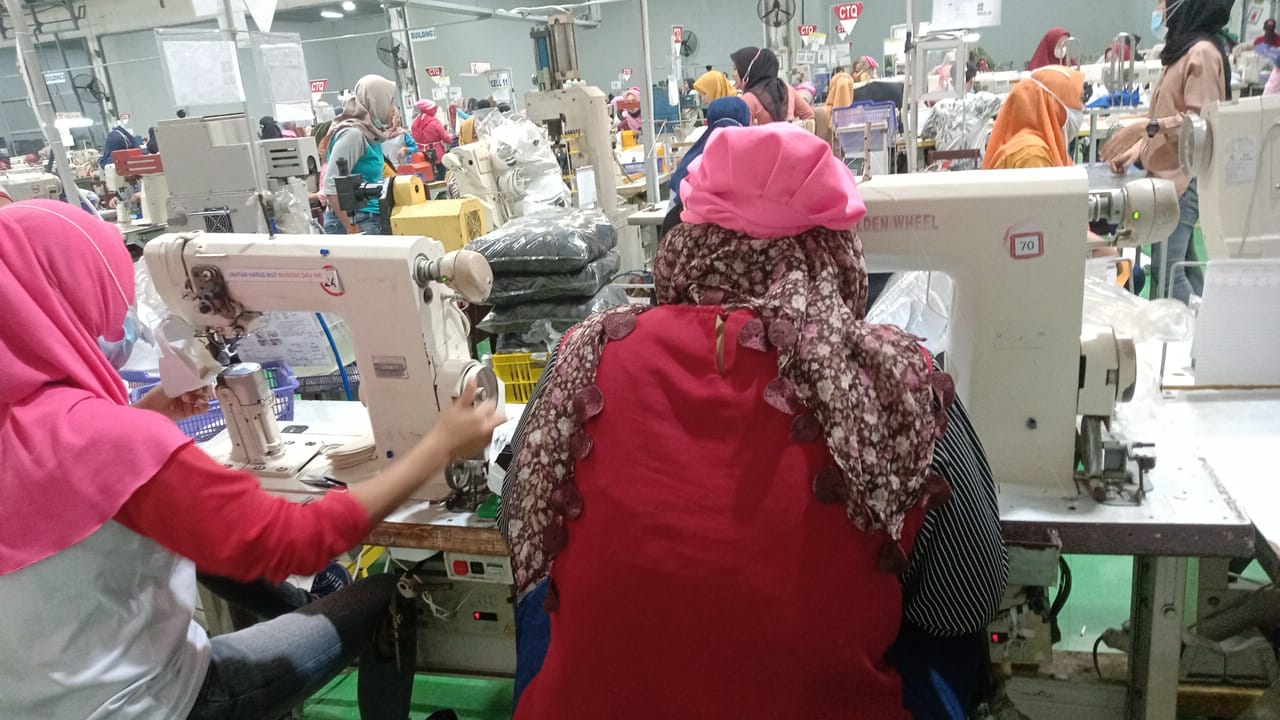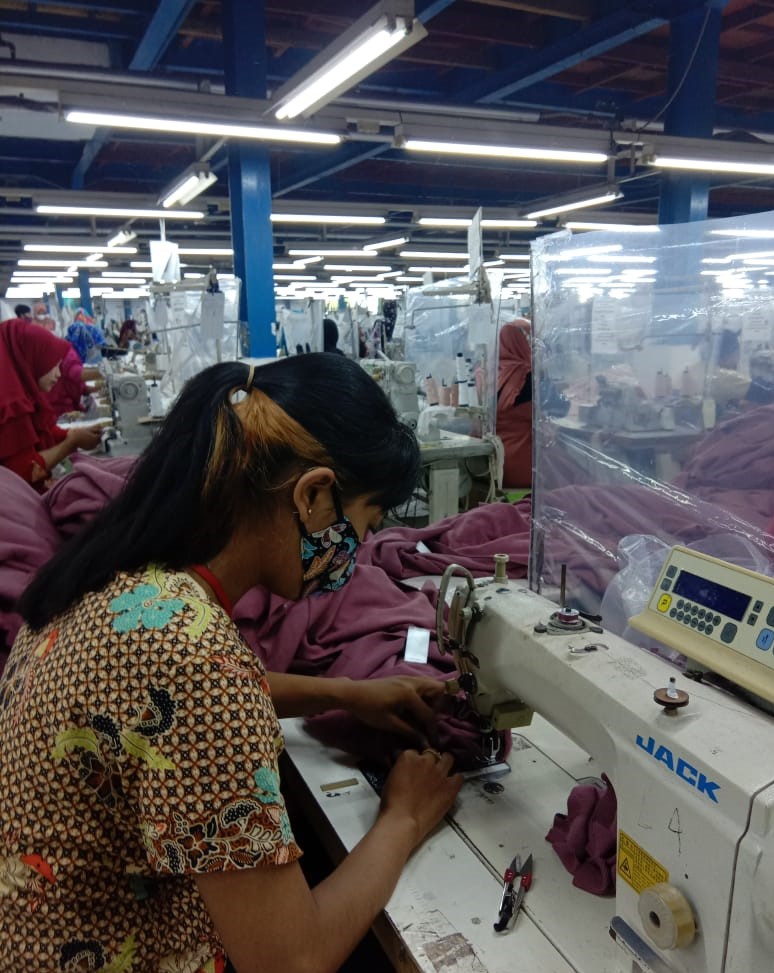Co-authored by Dian Septi Trisnanti, President of Federasi Serikat Buruh Persatuan Indonesia (FSBPI) union and Ranjana Sundaresan, Asia Floor Wage Alliance (AFWA)
The world became dark as Eva fell onto the factory floor. Just before she fainted, Eva felt thick blood running down her legs; it was both warm and painful. When she finally regained consciousness, she found herself lying in the company clinic. Fortunately, she didn’t have a miscarriage, but still needed to rest for four days.
Eva had earlier asked her supervisor for a break from work as the pregnancy was tiring her out – she operated two Kansai sewing machines and worked on two different processes for a manufacturer for Adidas in Indonesia. The supervisor refused because he thought she was lazy and was just looking for an excuse not to work. Even after she experienced bleeding, her boss didn’t allow her to go home and insisted she rested at the company clinic, “You don’t need to be given permission to go home, you will recover soon.”
Eva worked as a short-term contract garment worker with the hopes of having her contract extended from three months to a year. Her targets at the garment factory were quite high – 180 pieces per hour or 100, if the sewing model was complicated – and this is grueling, exhausting work at the best of times. She usually achieved this target by extending her working hours, which in turn let her get a bonus or calculated overtime. It also meant that she could earn more than the provincial minimum wage (UMP) in Jakarta, which was IDR 4.5 million or USD 315 in 2021.
But during her pregnancy, Eva often experienced nausea and vomiting. She had to go to the toilet at least five to seven times a day. As a result, she was rarely able to meet her targets, which in turn affected her income and her ability to manage her household expenses.
Eva is just one of the millions of women who work in Indonesia’s thriving garment industry. And sadly, her story is far from unique; it is, in fact, the norm. While mothers and motherhood are celebrated across the world, pregnant workers like Eva are penalized for taking on the duties of social reproduction.

Women are not compensated for social reproduction
Women are an integral part of the machine for social reproduction, the mechanism by which a society reproduces itself not just from one generation to another but also within generations.
Social reproduction, among many other aspects, includes cooking, cleaning, caring for others, and a whole host of household work that is important for a decent quality of life. The responsibility for these life-supporting tasks falls disproportionately on women, primarily because they are the child-bearers. Unfortunately, social reproduction is rarely seen as valuable or productive even though it prepares workers to enter the workforce, replenishes the existing workforce, and cares for those who can no longer be absorbed into the workforce.
The contribution of women to social reproduction as child-bearers and caregivers is often unrecognized, unpaid, underestimated, and taken for granted. In addition, women in low- and middle-income countries spend more time on unpaid work compared to high-income countries. This is true in the case of Indonesian women who are also wage-earners employed in direct economic activities. In fact, many women workers are the heads and breadwinners of their families, facts that are often ignored by the state.
Indonesia’s Marriage Law from 1974 labels men as “breadwinners” and women as “homemakers”, and these archaic notions still are pervasive in the country today. So much so that it impacts the wages of the two genders. In many private sector organizations, men continue to benefit from the breadwinner status, which allows for a salary component that takes into account the needs of their dependents. On the other hand, this component often is not paid to women in the Indonesian private workforce.
Instead, in determining wages, the Indonesian government sees women workers as individuals and refuses to recognize their dependents even though many women are responsible for the living needs of other family members. The government does not acknowledge the importance of social reproduction work and women’s contribution towards it.
Abuse of contract-based employment
Eva’s contract employment status is also not unique. Many supplier factories in Indonesia use such informal and insecure employment arrangements to bring down labor costs and make it easier to hire and fire workers. Contract workers cost less to employ per unit, often receive lower wages, rarely receive non-wage benefits (like paid leave and social security), and can be fired according to the shifting needs of brands.
The contractual working system thus allows factories to circumvent the minimum wage laws, which state that after a year of employment, workers can be paid more than the UMP and are eligible for additional wages based on company structure and scale. Contracts are usually for a year or less and when they expire, workers need to renew them as new employees once again. As a result, the UMP, meant to function as a social safety net, is actually the maximum wage.
And women are more likely to be hired through contractual or casual forms of employment. During the COVID-19 pandemic, the widespread use of short-term contracts and third-party manpower agency contracts were increasingly imposed on Indonesia’s women workers, rendering them significantly more vulnerable to job insecurity and abuse. These conditions prevailed despite the women having worked at the factories for many years as permanent employees.
Women on such contracts are even denied some of the basic benefits that Indonesian labor laws mandate, such as menstruation leave and maternity leave. Every Indonesian woman worker is entitled to two days of menstrual leave every month. Women workers are also guaranteed 13 weeks of maternity leave with 100% wages paid throughout the period. But many garment factories find ways to circumvent these laws and in the process exploit their women workers.
For instance, many companies allow menstruation leave to be “cashable”, meaning that it can be replaced with money if no day off is taken. Companies prefer this arrangement since it means work continues uninterrupted and women prefer it (even if they feel sick) since it means they can earn more money.
Some companies also force women to report their pregnancy by the fifth month and then stop paying them the menstruation leave compensation. In fact, in some places such as the Cakung Industrial Area, women contract workers who are about to give birth are forced to resign.
Several companies have a policy that reads “Especially for female employees, during the first year of the working contract period they are not allowed to get pregnant. If the female employee becomes pregnant, she is asked to resign, and the first party is not obliged to pay any compensation” (People’s Tribunal, 2014). They are allowed to return to work only after giving birth but have to re-apply as a new employee.

Gender bias in women’s wages
The issues mentioned above build a strong case for shifting to a system of living wages from the UMP.
Wages are meant to manage the living needs – not just the bare minimum – of families, nuclear and non-nuclear. The living wage, as opposed to the minimum wage, is a recognition of paid and unpaid labor, especially in the case of women. With a living wage, a worker should be able to provide for themselves and the basic needs of their families, including housing, food, education, and healthcare. When a woman oversees family income, she is more likely to put it back into the family and the community, which then has real potential to bring about intergenerational change to improve quality of life.
Wages in Indonesia are regulated in such a way that they are low in general and lower for workers who are especially vulnerable, which includes women. Take the example of domestic workers. They usually work more than eight hours a day but only receive 40% of Jakarta’s legal minimum wage. The low wages of domestic workers can be linked to sexist views regarding domestic work, which is seen as being of little value.
This same attitude toward women workers carries over to other industries, leading to a gender-biased division of labor where women earn lower wages than men for doing the same work. According to a 2020 study conducted by Asia Floor Wage Alliance, titled Money Heist: Covid-19 Wage Theft in Global Garment Supply Chain, women garment workers in low minimum wage regions (the UMP differs by province) in Indonesia reported earning an average monthly wage of USD139. This was 25% lower than male workers who received an average of USD185 per month. Even post-pandemic, women’s incomes remained persistently low while male workers’ incomes improved to pre-pandemic levels by the end of 2020. In addition, women tend to be confined to so-called “low-skill” jobs, making them more susceptible to wage theft and layoffs.
New regulations continue to ignore women
Indonesia’s new Omnibus Law on Job Creation came into force in early 2021 and contrary to what was expected, it has been the root of the decline in labor wages. But past labor laws were no better and made no special allowances related to the specific needs of women when determining wages. In the earlier law, the state had simplified the living needs of workers into a limited list of “Decent Living Needs,” but these did not cover the unique needs of women, such as reproductive health needs. Instead, past and present regulations focus only on aspects like menstrual or maternity leave rather than compensation, thus overlooking the full extent of a woman’s role in social reproduction.
Furthermore, the Omnibus Law did not protect contract workers. Wages in the law are calculated in bulk or according to targets based on per unit of time. But pregnant workers like Eva find it difficult to reach the target as they go into the later stages of pregnancy, during which time, women experience fatigue, frequent nausea, and vomiting. This means that they are not eligible for bonuses received for meeting targets. Instead, if wages are calculated based on the amount produced (or on a piece rate), income would fall below the provincial minimum wage.
And the minimum wage under the Omnibus Law did not increase much in 2022 – only by 1%. The backlash to the Omnibus Law saw it being replaced by the Job Creation Government Regulation In Lieu of Law, but this also had the same contents as before and didn’t protect or benefit workers. Instead, it causes greater uncertainty.
All of this underscores how gender inequality in Indonesian society has marginalized women in the country’s economic map even though they have contributed greatly to the country’s economy. Therefore, it is vital for workers to demand the determination of a wage that refers to the component of a decent living that accommodates the special needs of women to ensure it is no longer gender biased. Of course, determining the components of decent living needs should be based on the consumption survey of workers’ families involving grassroots workers, especially women.
AFWA’s living wage formulation is woman-centered and includes unpaid household and care work. In 2022, the Asia floor wage was calculated to be the equivalent of 1600 PPP$ per month.
|
Country Name |
PPP Conversion Factor 2022 | Local Currency for 1600 PPP$ |
| Indonesia | 5,067 |
8,107,632 Rupiah (IDR) |
Note: To understand how the living wage was calculated, please see our methodology here.
Today, Asia Floor Wage is internationally recognized as a credible and legitimate living wage benchmark for garment workers in Asia. The involvement of women workers in the survey is significant so that the proposed wages can include the needs of women and women’s perspectives as household finance managers. The process of determining wages is a space for women’s participation where women have the freedom as decision-makers, and of course, become the strength and spearhead of the struggle for a living wage. We believe that production countries like Indonesia need to move from a UMP toward a living wage, to ensure that the basic needs of all their workers are met.
